Quizalofop-P-tefuryl
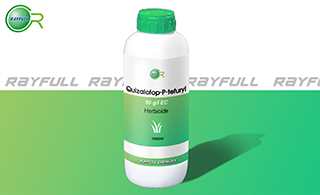 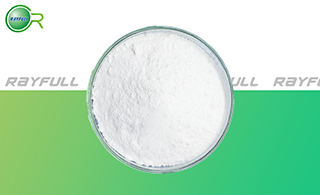 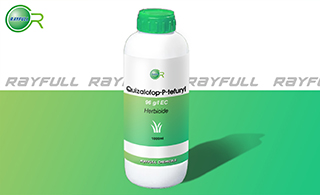 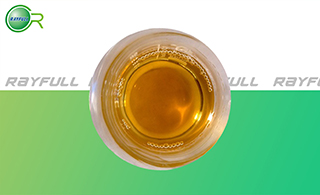 喹禾糠酯 喹禾糠酯
Introduction: Quizalofop-P-tefuryl is having selective post-emergence herbicidal effect on annual and perennial grasses in potato, soybean, sugar beet, peanut, oilseed rape, sunflower, vegetable crops, etc. Quizalofop-p-tefuryl (belonging to aryloxyphenoxypropionate) acts as systemic herbicide, absorbed from the leaf surface and translocates throughout the plant.
Common name: Quizalofop-P-tefuryl
Another name: Quizalofop-p-tefuryl solution; Quizalofop-P-tefuryl [ISO]; Propanoic acid, 2-[4-[(6-chloro-2-quinoxalinyl)oxy]phenoxy]-, (tetrahydro-2-furanyl)methyl ester; EC 414-200-4; etc.
Chemical name:
(RS)-tetrahydrofurfuryl (R)-2-[4-(6-chloroquinoxalin-2-yloxy)phenoxy]propionate
Empirical formula: C22H21ClN2O5
Structural formula:
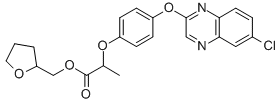
Mol. Weight: 428.89 g/mol
CAS No.: 119738-06-6
Specifications
Leading Quizalofop-P-tefuryl supplier
Quizalofop-P-tefuryl 90% TC
Quizalofop-P-tefuryl 40 g/L EC
Packing:
BULK PACKING
Powder: 25kg/Bag, 25kg/Drum, 50kg/Drum etc.
Liquid: 200L/Drum, 20L/Drum, 10L/Drum etc.
SMALL PACKING
Powder: 1kg/Alu bag, 500g/Alu bag, 200g/Alu bag, 100g/Alu bag, 50g/Alu bag, 15g/Alu bag etc.
Liquid: 5L/Drum, 1L/Bottle, 500ml/Bottle, 250ml/Bottle, 100ml/Bottle, 50ml/Bottle etc.
Customerized packing label
Quizalofop-P-tefuryl FAO standard
Professional registration
HAZARDS IDENTIFICATION
Hazard statement(s)
H302 (100%): Harmful if swallowed.
H341 (100%): Suspected of causing genetic defects.
H360 (100%): May damage fertility or the unborn child.
H373 (100%): Causes damage to organs through prolonged or repeated exposure.
H400 (100%): Very toxic to aquatic life.
H410 (100%): Very toxic to aquatic life with long lasting effects.
Precautionary statement(s)
P201: Obtain special instructions before use.
P202: Do not handle until all safety precautions have been read and understood.
P260: Do not breathe dust/fume/gas/mist/vapors/spray.
P264: Wash ... thoroughly after handling.
P270: Do not eat, drink or smoke when using this product.
P273: Avoid release to the environment.
P281: Use personal protective equipment as required.
P301+P312: IF SWALLOWED: call a POISON CENTER/doctor/... IF you feel unwell.
P308+P313: IF exposed or concerned: Get medical advice/attention.
P314: Get medical advice/attention if you feel unwell.
P330: Rinse mouth.
P391: Collect spillage.
P405: Store locked up.
P501: Dispose of contents/container to an approved waste disposal plant.
Supplemental Hazard Statements: none.
MAMMALIAN TOXICOLOGY
Acute toxicity: 1) Acute oral LD50 for rats is 1012 a.i.mg/kg. 2) Acute dermal LD50 for rats is >2000 a.i.mg/kg. 3) Acute inhalation toxicity LC50 (4 h) for rats is >3.9 a.i.mg/L. 4) Skin irritation: Non-irritating to skin (rabbits). 5) Eye irritation: Non-irritating to eyes (rabbits). 6) Skin sensitization for guinea pig: Sensitiser.
NOEL: (2 y) for rats is 1.3 mg/kg/day. Other Not genotoxic.
ADI 0-0.013 mg/kg b.w.
Classification:
WHO Classification: II (Moderately hazardous)
EC Risk Classification: Reproduction risk category 2 and 3: R61, R62; T - Toxic: R68; Xn - Harmful: R48/22, R22; N - Dangerous for the environment: R50, R53
US EPA Classification (formulation): III (Caution - Slightly toxic)
ECOTOXICOLOGY
Effect on birds: Acute oral LD50 for Bobwhite quail is >2150 a.i.mg/kg. Effect on fish: Acute LC50 (96 h) for Bluegill sunfish is 100 a.i.mg/l. Effects on aquatic invertebrates: Acute EC50 (48 h) for Daphnia magna is >1.51 a.i.mg/l. Effects on algae: Acute 72 hour EC50 for Pseudokirchneriella subcapitata is >1.9 a.i.mg/l. Effects on bees: contact acute 48 hour LD50 is >100 a.i.μg/bee, oral acute 48 hour LD50 is >100 a.i.μg/bee. Effects on earthworms: Acute 14 day LC50 is >500 a.i.mg/kg.
ENVIRONMENTAL FATE
Animals Extensively degraded by hydrolysis, hydroxylation and conjugation. Plants Rapidly hydrolysed to quizalofop. Soil/Environment DT50 1.9-22.0 h.
Usage: Quizalofop-P-tefuryl was introduced by Uniroyal Chemical Co., Inc. (now part of Crompton Corp.). It is a herbicide for the control of annual grass and broad-leaved weeds in a variety of crops.
Application: Biochemistry Fatty acid synthesis inhibitor (inhibition of acetyl CoA carboxylase) Mode of action Systemic herbicide, absorbed from the leaf surface, with translocation throughout the plant, moving in both the xylem and phloem, and accumulating in the meristematic tissue. Uses Control of annual grasses such as Avena fatua and Alopecurus myosuroides, and perennial grasses such as Sorghum halepense and Elymus repens, in potatoes, flax, oilseed rape, peas, sugar beet, cotton, and soya beans. Applied at 30-240 g/ha.
| 






